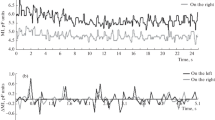The informational aspects of tissue microcirculation after sympathectomy were studied in 64 patients with complex regional pain syndrome using wavelet analysis of oscillations in blood flow in the microcirculatory bed of the skin. Early rearrangements of information in the trophotropic direction at the tissue level and the domination and preservation of this information throughout the microcirculatory network supports the optimal execution of adaptive reactions and, as a result, maximal treatment efficacy. In these cases, complete elimination of disease can be attained, with positive outcomes. Maximum therapeutic efficacy could not be obtained without early informational changes. Conversely, the dominance and preservation of ergotropic information in the early post-operative period constituted an unfavorable prognostic factor for the clinical outcome of sympathectomy. The formation of information exchange in the trophotropic direction in microvascular networks does not require tissue desympathization; achievement of a certain threshold level of decreased sympathetic activity is sufficient.
Similar content being viewed by others
References
N. N. Yakhno (ed.), Pain: Handbook for Doctors and Students, MEDpress-inform, Moscow (2009).
A. B. Danilov, “Complex regional pain syndrome,” in: Pain Syndromes in Neurological Practice, V. L. Golubev (ed.), MEDpressinform (2010), pp. 296–300
A. I. Krupatkin, “The effect of sensory peptidergic innervation on blood flow oscillations in human skin in the range 0.047–0.069 Hz,” Fiziol. Cheloveka, 33, No. 3, 48–54 (2007).
A. I. Krupatkin, “Oscillations in blood flow at a frequency of about 0.1 Hz in skin microvessels do not reflect the sympathetic regulation of their tone,” Fiziol. Cheloveka, 35, No. 2, 60–69 (2009).
A. I. Krupatkin, “Oscillatory blood flow structures reflect the dynamics of information processes in microvascular networks,” Fiziol. Cheloveka, 36, No. 2, 101–113 (2010).
A. I. Krupatkin, “Diagnosis of sympathetic-dependent pain in posttraumatic complex regional pain syndrome with laser Doppler flowmetry,” Zh. Nevrol. Psikhiat., No. 2, 46–50 (2012).
A. I. Krupatkin and V. V. Sidorov (eds.), Laser Doppler Flowmetry of the Microcirculation: Handbook for Doctors, Meditsina, Moscow (2005).
V. A. Frolov, T. Yu. Zotova, and A. K. Zotov, Disease as an Impaired Information Process, RUDN Press, Moscow (2006).
G. F. Gibbs, P. D. Drummond, P. M. Finch, and J. K. Phillips, “Unravelling the pathophysiology of complex regional pain syndrome: focus on sympathetically maintained pain,” Clin. Exp. Pharmacol. Physiol., 35, No. 7, 717–724 (2008).
J. Kastrup, J. Buhlow, and N. A. Lassen, “Vasomotion in human skin before and after local heating recorded with laser Doppler flowmetry. A method for induction of vasomotion,” Int. J. Microcirc. Clin. Exp., 8, 205–215 (1989).
P. Kvandal, A. Stefanovska, M. Veber, et al., “Regulation of human cutaneous circulation evaluated by laser Doppler flowmetry, iontophoresis and spectral analysis: importance of nitric oxide and prostaglandins,” Microvasc. Res., 65, 160–171 (2003).
P. Kvandal, S. A. Landsvert, A. Bernjak, et al., “Low-frequency oscillations of the laser Doppler perfusion signal in human skin,” Microvasc. Res., 72, No. 3, 120–127 (2006).
S. N. Raja, “Diagnosis of sympathetically maintained pain: the past, present and future,” Eur. J. Pain, 14, 45–50 (1993).
D. G. Silverman and R. G. Stout, “Distinction between atropine-sensitive control of microvascular and cardiac oscillatory activity,” Microvasc. Res., 63, 196–208 (2002).
Author information
Authors and Affiliations
Corresponding author
Additional information
Translated from Zhurnal Nevrologii i Psikhiatrii imeni S. S. Korsakova, Vol. 113, No. 6, Iss. I, pp. 17–21, June, 2013.
Rights and permissions
About this article
Cite this article
Krupatkin, A.I. Informational Aspects of the State of the Microcirculation after Surgical Sympathectomy in Post-Traumatic Complex Regional Pain Syndrome. Neurosci Behav Physi 44, 1059–1063 (2014). https://doi.org/10.1007/s11055-014-0024-1
Published:
Issue Date:
DOI: https://doi.org/10.1007/s11055-014-0024-1




